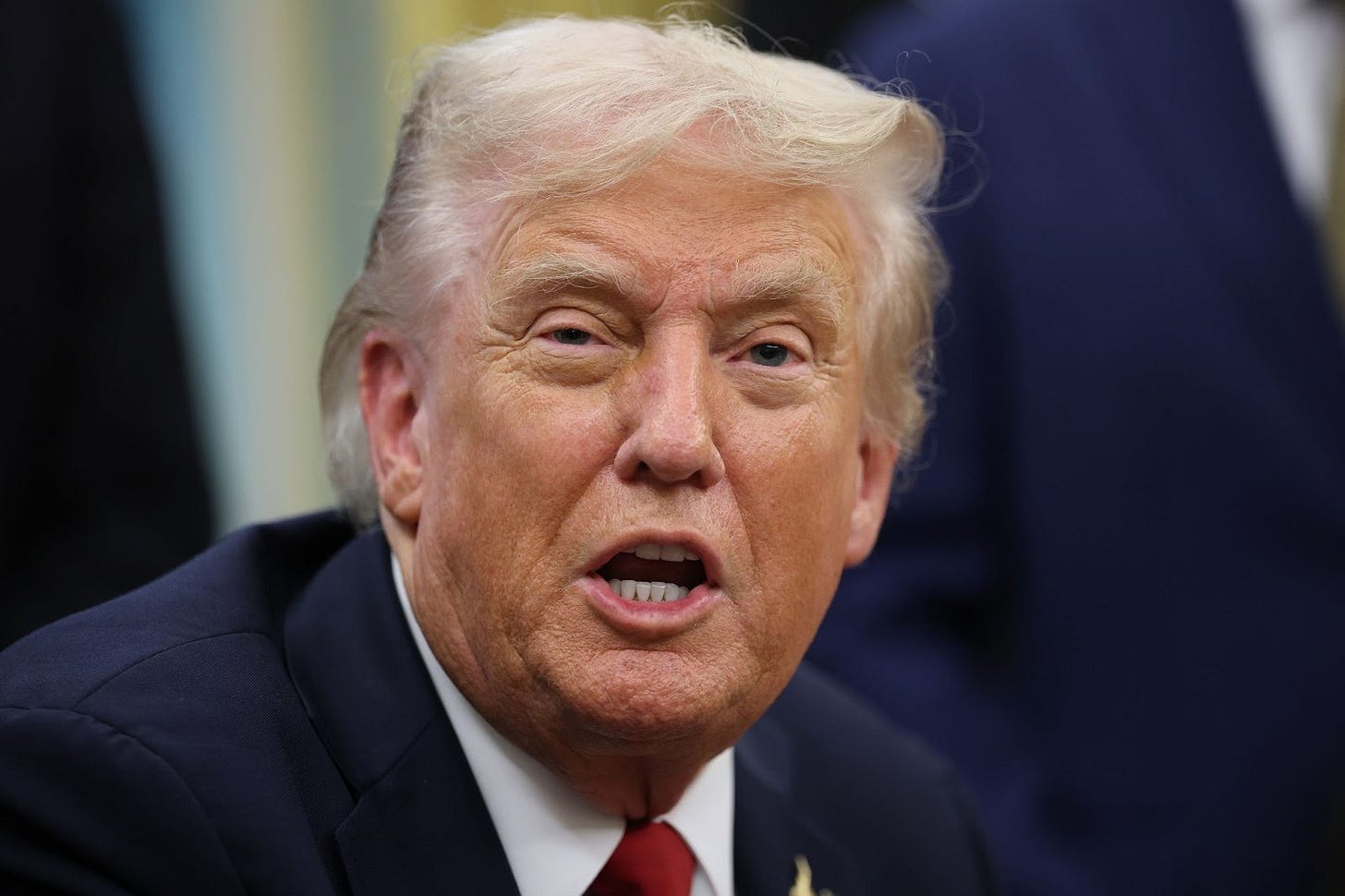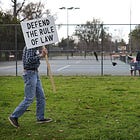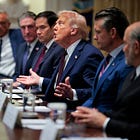No, America Is Not Experiencing Fascism. Yes, You Should Still Worry
A response to Niall Ferguson.
Writing after the assassination of Charlie Kirk, the Hoover Institution’s Sir Niall Ferguson offers comforting reassurance. Warnings of America’s democratic collapse are overwrought. The United States, according to Ferguson, remains “a very long way from Italy in 1927 or Germany in 1938.”
What Ferguson is thinking of is not just the fulminations of Trump’s progressive critics. Even conservative Andrew Sullivan wrote this summer in The Weekly Dish: “I think this is how a republic dies.”
In response, Ferguson catalogs a seemingly impressive list of institutional safeguards still operating. Courts issuing injunctions. The Republicans’ wafer-thin majorities in Congress. Lawyers with “a vested interest in preserving the rule of law.” His message is clear: those sounding alarms about institutional collapse suffer from “Windrip Syndrome”—a term Ferguson adapts from Sinclair Lewis’s 1935 novel It Can’t Happen Here to describe mistaking contemporary political turbulence for fascist takeover.
Ferguson is right on one level. America has experienced nothing like the Night of the Long Knives. But that misses the real test: Are the checks and balances of constitutional democracy being so hollowed out that democracy is at real risk? The evidence suggests this to be the case. Trump’s systematic capture of law enforcement, regulatory agencies, and emergency powers achieves tyranny in all but duration—authoritarian control operating through constitutional forms.
The president’s crowning achievement since taking office has been transforming the constitutionally outrageous into the contemporary routine. The relentless cascade of norm violations creates its own anesthesia. When everything is scandalous, nothing shocks. Across multiple domains—law enforcement, regulation, press freedom, and emergency powers—Trump has systematically converted democratic institutions into instruments of personal will. The result weaponizes federal powers to punish opponents and reward loyalty. The methods may be legal in form. But the function remains authoritarian.
Ferguson’s analysis overlooks this reality in three ways. He focuses on the relative absence of fascist imagery and misses the significance of Trump’s regulatory authoritarianism. He sees routine power-stretching where there is systemic presidential overreach. And he treats litigation volume as health rather than as a symptom of executive defiance.
The Fascism Fallacy
Ferguson’s first misstep is foundational: measuring threats against 1930s fascist imagery rather than democratic norms. The fascist yardstick obscures how effectively American institutions have been captured. The question isn’t whether Trump resembles Mussolini’s blackshirts or Hitler’s brownshirts. It’s whether law enforcement and regulatory agencies now operate as instruments of presidential will rather than neutral arbiters of law.
Consider the capture of law enforcement. At the Justice Department, dozens of officials linked to January 6 prosecutions have been fired or reassigned, replaced by loyalists, including former Trump defence lawyers. The acting deputy attorney general ordered FBI personnel lists targeting those who worked Capitol riot cases. This move facilitated retaliation against law enforcement professionals who simply did their jobs. The administration stripped Secret Service protection from John Bolton and Mike Pompeo, Trump critics who served during his first term, despite active Iranian assassination threats. Personal vindictiveness now drives personnel decisions involving life and death.
Ferguson might note that presidents have legal authority to dismiss Justice Department officials who serve “at the pleasure of the president.” He would be correct about the legality. But his focus on legal procedures misses the constitutional point: when law enforcement becomes an extension of presidential will rather than an independent check on it, you no longer have the rule of law. You have law by rulers—a distinction Ferguson’s procedural focus obscures.
The pattern of capture operates in press intimidation. After Jimmy Kimmel’s comments about Charlie Kirk’s assassination in September, FCC Commissioner Brendan Carr warned Disney they could “do this the easy way or the hard way.” The threat worked immediately—affiliates dropped the show, Disney suspended it indefinitely. When ABC reinstated Kimmel days later, Trump threatened the network again: “I can’t believe ABC Fake News gave Jimmy Kimmel his job back… I think we’re going to test ABC out on this.” The Kimmel episode followed an all-too-familiar pattern, beginning with the Associated Press being barred from briefings for refusing to adopt White House terminology about the “Gulf of America.” Trump made his intent clear when he told reporters late last month that networks giving “only bad publicity” should “maybe” have their licenses revoked.
Step by step, regulatory intimidation moves towards what jackbooted censors accomplished in the 1930s—journalism operating at the government’s pleasure rather than by constitutional right. Major outlets still publish critical coverage daily, but their persistence obscures how the structural foundations are being undermined. Critical journalism now operates under the shadow of regulatory threats rather than being protected by institutional independence. The absence of 1930s theater doesn’t provide comfort; it provides camouflage for more sophisticated methods of control.
Ferguson’s historical lens thus becomes counterproductive. By conjuring up dramatic fascist imagery, he overlooks regulatory capture that systematically undermines press independence through different means.
The Normalization Trap
Ferguson’s second shortcoming lies in treating Trump’s systematic coercion as routine presidential power-stretching. He argues that the “imperial presidency” stretches back generations, citing Franklin Roosevelt’s New Deal as “a power grab by the executive branch” and Barack Obama’s use of “legally dubious threats to yank federal funds from universities.” This historical framework suggests constitutional friction represents normal political weather, not democratic breakdown.
But Ferguson’s normalization obscures a crucial distinction. Testing constitutional boundaries differs from methodically demolishing them. Roosevelt’s New Deal faced Supreme Court resistance and adapted its approach accordingly. When the Court struck down key legislation, Roosevelt changed tactics rather than ignore the ruling. Obama’s university funding threats operated through existing legal frameworks with congressional oversight. When universities challenged the policy, his administration negotiated rather than escalated. Both presidents tested boundaries but accepted institutional pushback.
Trump, by contrast, has articulated a philosophy that dispenses with limits altogether. In February he pinned a message to Truth Social and X declaring: “He who saves his Country does not violate any Law.” This was no casual boast but a statement of principle, echoing the Napoleonic doctrine that sovereignty lies in deciding when law no longer binds. In Trump’s formulation, the test of presidential legitimacy becomes not fidelity to the Constitution, but the leader’s self-proclaimed mission to “save” America.
Trump has put this philosophy into practice through an unprecedented blizzard of executive orders. In his first months, he attempted to strip birthright citizenship by decree, barred asylum rights under a declared “border invasion,” imposed “Liberation Day” tariffs without congressional authorization, and ordered nominally independent regulators like the Federal Election Commission, Securities and Exchange Commission, and Federal Trade Commission to submit budgets and rules to the White House for clearance. Each measure has been challenged in the courts, but the pattern is unmistakable: executive orders are no longer used to implement law but to supersede it.
Previous presidents tested executive boundaries, but within constitutional frameworks and subject to institutional correction. Trump’s approach differs fundamentally: the sheer volume and constitutional audacity of his orders overwhelm the system’s capacity to respond. By the time courts rule on birthright citizenship or regulatory independence, executive action has already reshaped reality on the ground. Emergency deployments continue despite adverse rulings. Regulatory changes proceed whilst appeals drag on. The legal process becomes reactive theater rather than effective constraint: courts can vindicate rights in theory whilst failing to constrain power in practice.
Meanwhile, the president uses regulatory power as a shakedown mechanism. The White House cleared Nvidia’s and AMD’s China chip licenses on the understanding the government would take 15% of those sales—a license-for-revenue toll. An executive order stripped law firm Paul Weiss of clearances and federal work until they offered concessions and publicly disowned a former partner. And Paramount paid to settle a 60 Minutes suit while seeking administration sign-off on its Skydance sale. The message to boardrooms is plain: compliance buys protection; resistance invites pain.
The pattern extends beyond regulatory coercion. What began as a promise to strip politics out of universities receiving federal funding has mutated into something far more dangerous. It’s now a federal power grab that tells institutions whom they may admit, what they may teach, how they may govern, and even which student groups may exist. Harvard filed federal lawsuits challenging the administration’s constitutional authority, while others capitulated entirely. The pattern reveals organized coercion: resist and face annihilation; comply and surrender autonomy.
Meanwhile, the transformation of the presidency into a personal profit center operates in plain sight. The Trump family launched cryptocurrency ventures, attracting $2 billion from an Abu Dhabi firm and $75 million from Chinese-connected investors. This happened just as crypto regulatory oversight was dismantled. Qatar “gifted” a $400 million jumbo jet destined for Trump’s presidential library. It’s Plunkitt’s “honest graft” for the influencer age—the fusion of public power and private brand until the distinction barely matters.
Scholars and pundits have an obligation to recognize the severity of what is occurring—and to see it as unprecedented in American history, at least outside of wartime. By treating systematic coercion as familiar power-stretching, analysis like Ferguson’s delays recognition of institutional capture even as it accelerates. When democratic erosion operates through legal processes rather than dramatic rupture, the window for effective resistance narrows rapidly—making scholarly reassurance counterproductive.
Institutional Theater
Ferguson is also on shaky ground when he equates institutional survival with democratic health. He celebrates that courts are “grappling with close to 400 cases involving the Trump administration.” He notes that America retains “1.3 million practicing lawyers” with “a vested interest in preserving the rule of law.” These metrics suggest institutional resilience—democracy’s immune system responding to authoritarian infection.
But Ferguson is not sufficiently differentiating form from substance. The sheer volume of litigation against Trump’s policies doesn’t demonstrate judicial constraint; it reveals executive defiance requiring constant legal intervention.
Military deployments demonstrate this institutional theater perfectly. National Guard troops have remained on the streets of U.S. cities whilst courts issue injunctions that are promptly stayed on appeal. What once would have triggered a constitutional crisis now passes as routine public safety. Ferguson might note that federal courts ruled Guard operations unlawful under the Posse Comitatus Act—evidence of judicial independence checking executive overreach. But when injunctions are stayed on appeal and hundreds of troops remain deployed after their authorization dates have expired, the legal system becomes performative rather than protective.
The same pattern operates with universities. Ferguson could point to Harvard’s federal lawsuit challenging funding freezes. He might see this as proof that institutional independence survives. But institutions now align their policies in advance to avoid prolonged litigation. Legal remedies become irrelevant to practical outcomes. The threat of funding cuts achieves compliance without formal enforcement.
Ferguson’s confidence in institutional forms reveals the limitations of historical analogy. Europe’s 20th-century fascists abolished democratic institutions outright. They dissolved parliaments, shuttered courts, and banned opposition parties. Contemporary authoritarians preserve institutional forms but drain their constraining power. Normalization through exhaustion makes oversight impossible.
The Perils of Reassurance
Ferguson’s approach underestimates the dangers of the erosion we are experiencing. When a respected historian assures the public that institutional forms guarantee democratic substance, it can become harder to see the erosion for quite the menace that it is.
Public understanding shapes political response. If voters believe safeguards remain robust, they demand less protection. If journalists accept that press freedom persists because some criticism continues, they miss how methodically their independence is being gutted. If politicians hear that courts check executive power, they see less urgency in defending legislative prerogatives.
Ferguson is technically correct that America hasn’t become Mussolini’s Italy. But so what? Trump’s concentration of regulatory, judicial, and emergency powers achieves authoritarian control without the historical theater. The rule of law doesn’t require jackboots to die.
As James Madison warned in Federalist 47, “The accumulation of all powers, legislative, executive, and judiciary, in the same hands… may justly be pronounced the very definition of tyranny.” Trump’s systematic concentration of power through regulatory coercion and institutional capture realizes Madison’s warning—the accumulation of all powers accomplishing what the Founders defined as tyranny. Reassurances like Ferguson’s risk offering false comfort while this reality unfolds behind the preserved forms they celebrate.
Roger Partridge is a founder and senior fellow of The New Zealand Initiative and writes on public policy, constitutional law and liberalism. He publishes on Substack at Plain Thinking.
Follow Persuasion on Twitter, LinkedIn, and YouTube to keep up with our latest articles, podcasts, and events, as well as updates from excellent writers across our network.
And, to receive pieces like this in your inbox and support our work, subscribe below:







What I still don't understand is how the democrats missed the fascism during Biden's term.
Covid panic, lockdowns, school closures. What do you call it when there is a state of emergency for years, even when it is clear that this lab created virus was not much worse than a bad flu? Be honest, for most people it wasn't. I know that because I am unjabbed and I got it twice and I have dozen of unjabbed friends of all ages and they all got it- and all survived. I also read research. Would we even be arguing about this if covid had been the deadly plague that they claimed and used to justify the lockdowns, school closures and mandates?
Biden mandated the covid vaccine, a brand new mrna lipid nanoparticle concoction. Pregnant women were required to get this vaccine or lose their jobs! It had never been tested. Later we found out that the vaccine was also never studied to see if it prevented transmission. ( it didn't). So why mandate it?
I could go on and on, and also about censorship and deplatforming critics of school closures, lockdowns and vaccine mandates. The democrats refuse to even talk about this. YSo sorry, Cry me a river about fascism, about lawfare ( you did it too), about censorship ( you did it). I just dont believe or trust you.
James Madison said, “A democratic republic requires a well-informed electorate.” If true, and I believe it is, the democracy is already gone.